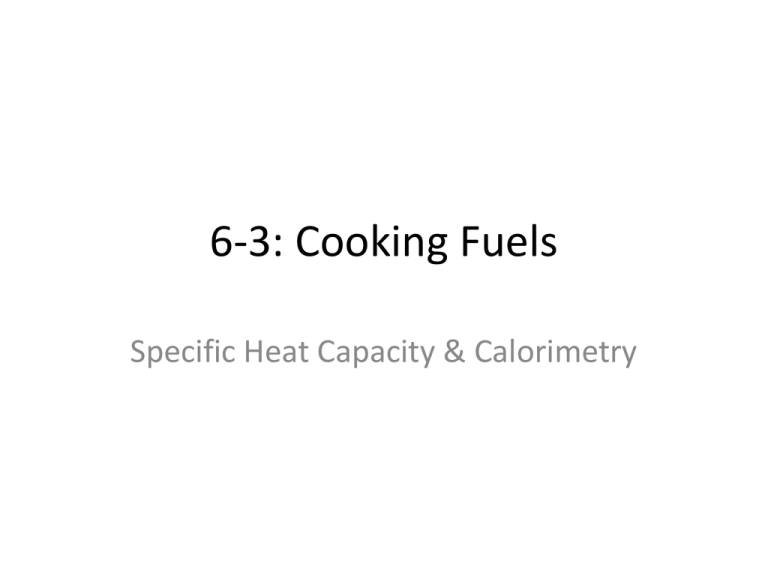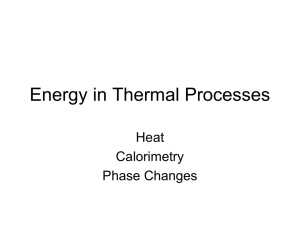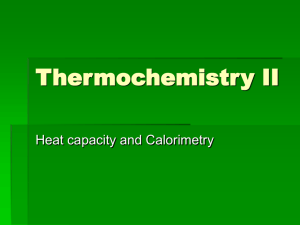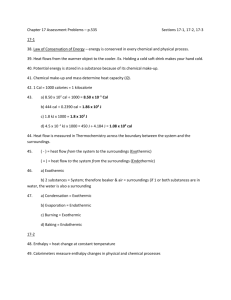Heat
advertisement

6-3: Cooking Fuels Specific Heat Capacity & Calorimetry Do Now 1. What is the difference between heat and temperature? 2. What are the reactants and products in complete and incomplete combustion? 3. In the pictures below describe the heat transfer process that is occurring Do Now • Heat is the energy from the motion of molecules, and temperature measures the average speed of moving molecules • Complete combustion: CxHy + O2 CO2 + H2O • Incomplete combustion CxHy + O2 CO2 + H2O + C + CO Do Now Convection – fluids transfer heat through movement Conduction – heat is transferred by molecules vibrating and touching each other Objective • I can calculate the energy contained in different snack foods using a calorimeter and the heat equation in a lab experiment and report. Agenda 1. 2. 3. 4. Do Now, Objective (10 min) Vocabulary Preview (10 min) Calorimetry Lab (50 min) Heat Notes (20 min) Homework • Complete Calorimetry Lab Report – Show all calculations on a separate sheet of paper – Use correct units of measurement at all times DUE Friday! Vocabulary Preview • Thermochemistry: the study of heat effects that accompany chemical reactions. • When you measure the quantities of heat gained or lost in chemical reactions you are investigating the thermochemistry of those reactions. • Endothermic: energy is ABSORBED by the system from the surroundings • Exothermic: energy is RELEASED from the system to the surroundings Lab Background • Follow along as we read the Background section of the lab as a class • First Law of Thermodynamics: energy cannot be created or destroyed, it can only change form Lab Background Lab Background • Calorimetry: the measurement of heat transfer from one object to another. • Today you will look at how much heat is transferred to water when different snack foods are burned as fuel. Lab Background • Specific Heat Capacity: the heat energy needed to raise the temperature of 1 g of a substance 1ºC. – Water’s specific heat capacity = 1 cal/g ºC Lab Background • calorie: the amount of heat energy required to raise the temperature of 1 gram of water 1ºC. – 1 calorie = 4.184 J – 1000 cal = 1 kcal – 1 nutrition Calorie = 1 kcal Calorimetry Lab • • • • Work in groups of 3 – 4 Collect materials BEFORE you go outside All lab write-ups must be done individually Don’t play with burning food Group Discussion • What foods released the most energy? • How can you tell these foods released more energy? • What do you think gives certain foods more energy than others? Heat Notes • When fuels are burned they release heat energy Heat Notes • The heat released when you burned snack foods was used to heat water and raise its temperature Heat Notes • Heat and temperature are not the same thing – Heat: a measure of the total energy in a system (joules or calories) – Temperature measures the kinetic energy (motion of molecules) in a system. Heat Notes • A calorie is the amount of heat needed to raise the temperature of 1 g of water 1ºC – 1 calorie = 4.184 Joules • 1 food Calorie = 1 Kcal = 1000 cal Plicker Question • How many Joules are in 3 calories? a) 3000 b) 12.5 c) 0.7 d) 4184 Heat Notes • To calculate the heat per gram of fuel used in your lab, you need to know the specific heat capacity of water Specific heat capacity of water = 1 cal/g ºC This is how much heat you need to raise the temperature of 1 gram of water by 1ºC Plicker Question • How much heat, in calories, is required to raise the temperature of 1 gram of water 5ºC? a) 1 cal b) 5 cal c) 0.2 cal Heat Notes • You can determine how much heat energy is released as a fuel burns with this equation • • • • Q = mcΔT Q = change in heat m = mass of water in grams c = specific heat capacity of water ΔT = the change in temperature of the water Practice Question • When a peanut was burned, 25 grams of water was heated from 10ºC to 30ºC. How much heat (in calories) was released by the peanut? – Q = mcΔT – Q = (25 g)(1 cal/gºC)(20ºC) – Q = 500 calories (aka 0.5 Cal) Heat Notes • You can also calculate the energy content per gram of fuel. This is done by dividing the heat gain (Q), by the change in the mass of the food sample. • Energy content by mass = Q/Δmass Plicker Question • A 2 g marshmallow was burned, and remassed at 1.5 g. The burning marshmallow raised the temperature of 6 g of water from 15ºC to 27ºC. What is the energy content per gram of the marshmallow? a) b) c) d) 72 cal/g 36 cal/g 48 cal/g 144 cal/g Heat Notes • Endothermic reactions absorb heat – It takes energy to break chemical bonds – Endothermic reactions are absorbing energy to break the bonds between atoms and molecules • Exothermic reactions release heat – Energy is released when bonds form – This energy is stored in the chemical bonds of molecules – Exothermic reactions are releasing energy to form new bonds between atoms and molecules Plicker Questions • Breaking chemical bonds is what type of process? a) b) c) d) Endothermic Exothermic Hypothermic hyperthermic Plicker Questions • How much heat is required to change the temperature of 150 g of water by 20ºC? a) b) c) d) 3000 cal 0.13 cal 7.5 cal 150 cal Exit Ticket • Answer the exit ticket silently at your table. When you are finished turn it into the bin.







